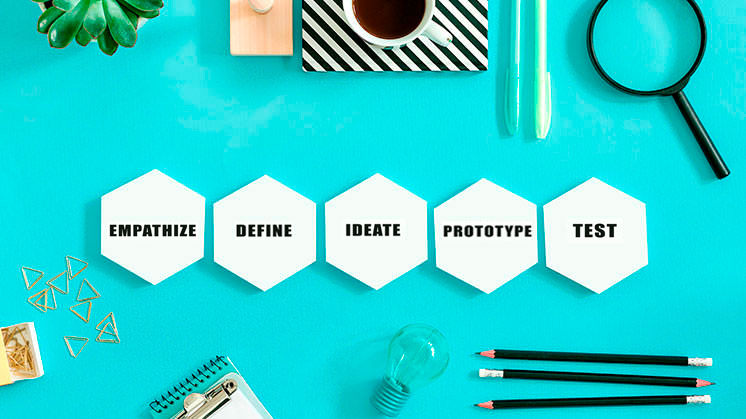Nike, Apple, Ikea … These are undoubtedly among the world’s most successful brands, if not the most successful. Why? Largely because their products are considered simple, comfortable, and easy to use. While Nike is the brand of choice for most world-famous athletes, owning an Apple product is considered a status symbol, and Ikea’s popularity is owed to its low-cost, well-designed products.
What ties these brands together? It’s design thinking — an user-first approach that combines customer desire with what is economically viable for business. The principles are often applied to product and experience development, but in this piece, I’m going to tell you how to tackle marketing campaigns with Creative Problem Solving (CPS) backed by design thinking.
First, let’s look at the relationship between the two. Simply put, design thinking represents an evolution of the CPS methodology. The main difference between the two being that design thinking incorporates methods such as prototyping and testing with traditional CPS.
Now, picture this, your brand is launching a marquee product or service in the next couple of months, and you have been tasked with conceptualising and implementing a massive marketing campaign around the same. How would you ensure its success? How would you ensure it communicates what it’s meant to? You guessed it — just follow the steps of design thinking! Here they are:
Empathise: This first step is what truly sets design thinking apart. Take the time to explore the mindset of your target group. Deploy surveys, or even better, set aside time for face to face interviews. Most importantly, do it with the intention of understanding, not judging.
Define: Next, define the core personas based on the results of the interviews. List out what their challenges and needs are, as well as the factors that influence their buying decisions.
Ideate: Organise a brainstorm and collaborate. Throw concepts at each other, explore the pros and cons of each. Select your top three.
Prototype: Start with low-fidelity prototypes such as storyboarding and sketching. These are great to start with since they’re fast, inexpensive, and easy to iterate. Make sure to test these against expected user responses.
Testing: This final step can also be done alongside prototyping. Say, if you’re planning a content marketing campaign, this phase would involve A/B testing with different approaches such as videos, blogs, and infographics. Once enough iterations are performed, go ahead with what works best. E.g. If you defined three distinct problem statements, testing will help you identify and focus on what resonates the most.
As you can see, it’s a simple yet comprehensive process — at the core of which lies setting a strategic intention. A popular German automobile brand aced this with its ‘Fun Theory’ campaign back in 2009. The primary insight this campaign was based on was fairly simple — it’s easy to change people’s habits if you make it fun. And a human-centric insight like this is only made possible with an empathetic approach such as design thinking!
One part of this campaign was getting people to use the stairs instead of the elevator or escalator. This seemingly impossible task was achieved in the most creative of ways — turning the stairs into a piano! As soon as this was done, people were seen avoiding the escalator, instead, walking, running and even jumping on the musical stairs!
Now you may be wondering what this had to do with the brand’s offering, i.e. cars. The answer? The campaign was created to generate interest around BlueMotion Technologies — a series of cars and innovations that help reduce environmental impact without compromising on the joy of driving. The challenge was to launch Volkswagen’s BlueMotion technologies when environmental focus was seen as a necessity, not an interesting difference. The message being pushed via this campaign was that the brand in question made it easier to choose eco cars by giving them a twist — i.e. focusing more on performance and driving experience and promoting a better choice through fun! Ingenious, isn’t it?
An insight like this and a campaign as out-of-the-box as this one can only be done with a human-centered approach such as design thinking. The best part? We can all leverage these principles. So get started, and your next campaign could be the most groundbreaking one yet!
| Applied the thinking to their cars. We also created a competition called the Fun Theory Award, where we asked people to compete with their own ideas for helping people make better choices through fun.
The Situation: Volkswagen asked us to create a campaign that would generate interest around BlueMotion Technologies. A series of cars and innovations that help reduce environmental impact without compromising on performance or the joy of driving. Our challenge was to launch Volkswagen’s BlueMotion technologies when the eco car market was booming, and an environmental focus was more of a necessity than an interesting difference. How could we interest people in a new eco car line when most people saw it as ”more of the same”, and how could we get across the innovative thinking of VW? The Strategy: Our insight was that VW made it easier to choose an eco car by making them more fun – that they brought a new twist to eco cars by focusing more on performance and driving experience , thus promoting a better choice through fun. We wanted to spread this innovative thought, that showed VW’s visionary thinking and had a wide range of applications beyond cars. Thus, our solution wasn’t a big conventional ad campaign pushing the technology and how it made the cars fun to drive. We wanted something more visionary, something different. |
Not much. And that’s precisely the beauty of design thinking. It shows you that selling isn’t always the way, sometimes, taking the road less travelled may have an even better result for the brand. In this case, the automobile manufacturer was rewarded with a major boost in relatability and likeability,
From the iPhone to everyday furniture, design thinking has enabled some of the world’s most beloved brands like Apple and Ikea to develop intentional and human-centric products. Often used in product and experience development, more marketers and startups are now incorporating design thinking in the way they approach marketing and branding initiatives.
Design begins with setting a strategic intention. If you are mapping out a strategy, you are designing.
Creative problem-solving with the Design Thinking Model
Design Thinking and Creative Problem Solving (CPS) are both used to develop or redesign products, services, experiences, systems, processes, and workflow for change. Design Thinking represents an evolution of the CPS methodology. The primary difference between Design Thinking and CPS is that Design Thinking incorporates classic CPS with methodologies such as ethnography, prototyping, and testing.
What has made design thinking so widely adopted around the world is the 4th element: an emphasis on empathy. Empathy is “the action of understanding, being aware of, being sensitive to, and vicariously experiencing the feelings, thoughts, and experience of another” (Merriam Webster dictionary).
It brings together what the customers’ desire with what is technically feasible and economically viable for business.
The views and opinions published here belong to the author and do not necessarily reflect the views and opinions of the publisher.



Be the first to comment on "Creative problem solving with design thinking — the key to pioneering marketing campaigns"